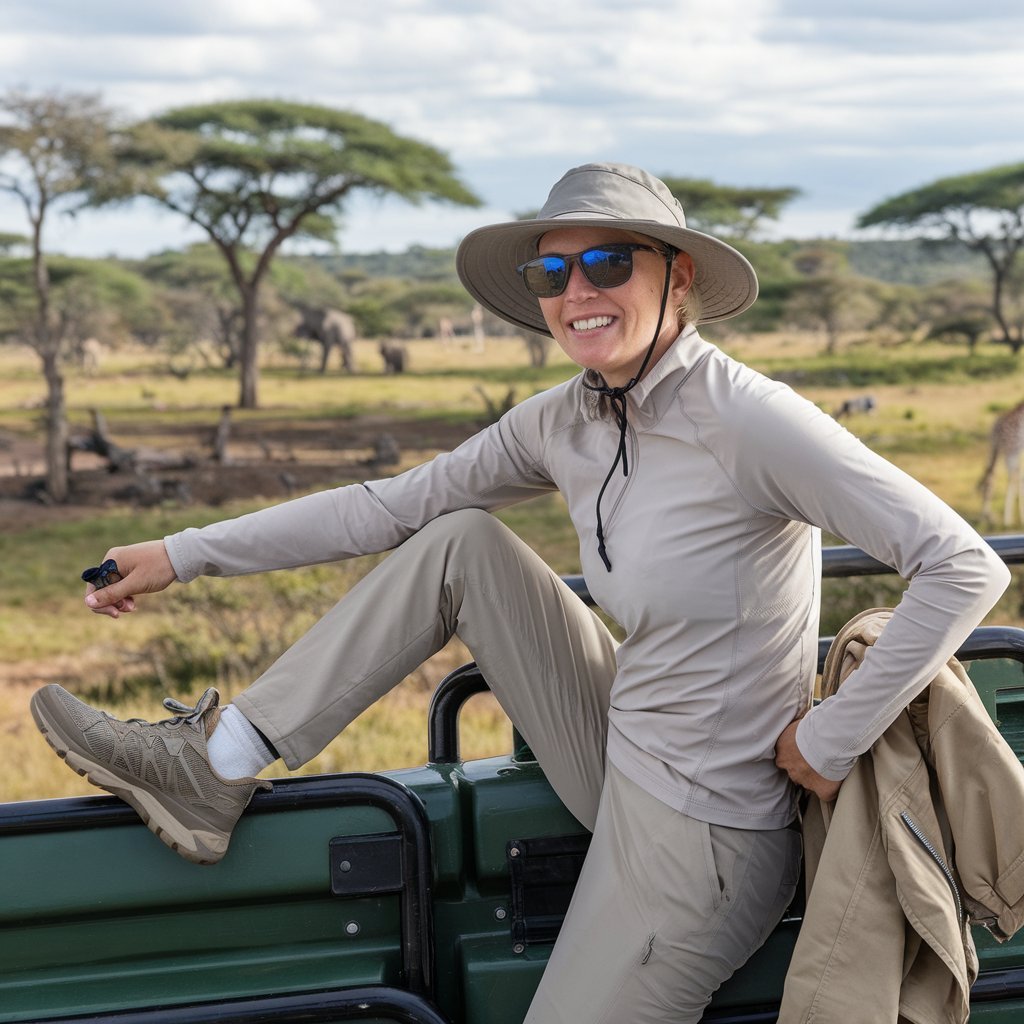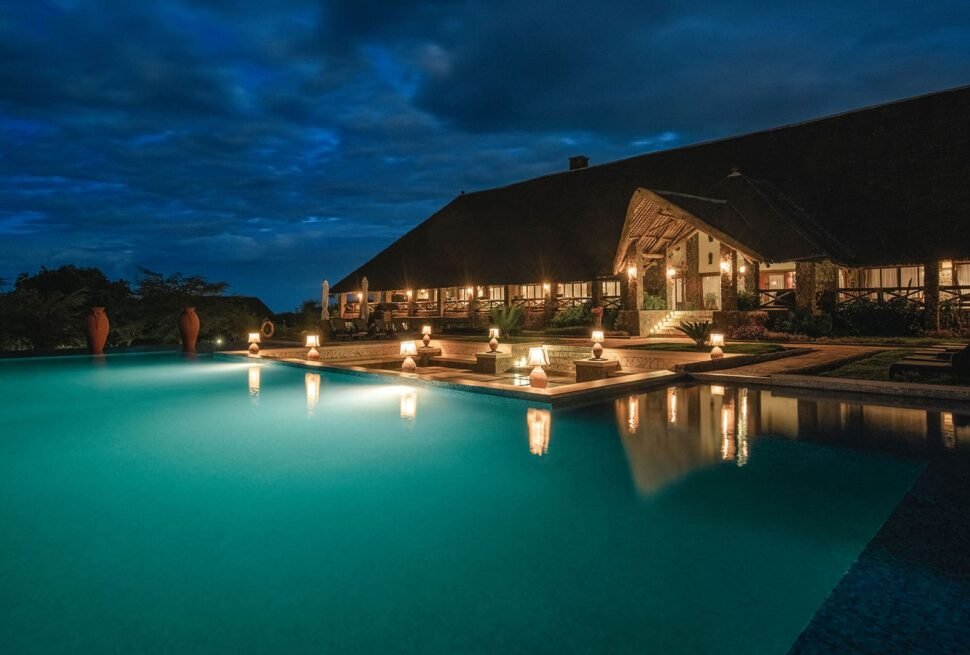So—you’re going on a safari in Tanzania? First of all, YESSS! You’re in for the trip of a lifetime. Seriously, there’s nothing like watching elephants cross the Serengeti at sunset or hearing lions rumble in the distance while you sip your coffee at sunrise. But figuring out what to wear for your safari can feel overwhelming. Do you need fancy safari clothes? Will you melt in the sun? Are you going to get eaten alive by mosquitoes?
Don’t worry—I got you. This guide breaks down exactly what to wear (and what not to) for your safari in Tanzania, based on real experience and zero fluff. Let’s make sure you’re comfy, protected, and looking good for those epic safari pics.
🟢 Why What You Wear Actually Matters
Okay, so safari style isn’t just about looking like you stepped out of a travel catalog. The right clothes make a huge difference out there. You’ll be spending long hours in a jeep, often in the sun, sometimes in chilly mornings, occasionally in light rain, and always surrounded by dust.
Here’s what your clothes need to do:
- Keep you cool during the day but warm in the morning.
- Protect you from sunburn and mosquito bites.
- Help you blend into nature (bright colors = no bueno).
- Not make you miserable after hour three in a bumpy Land Cruiser.
🎨 Safari Color Palette 101
Stick to neutral, earthy tones. Think: olive, tan, beige, light brown, dusty green. These colors don’t attract insects, and they help you blend in better—which makes animals less likely to run off when they see you.
Avoid:
- Black & dark blue – They attract tsetse flies. You don’t want those.
- Bright colors – Reds, oranges, neon anything? Leave ’em at home.
- White – It gets dirty in 0.2 seconds and reflects light like crazy.
🧢 Head-to-Toe Safari Clothing Guide
Let’s go top to bottom. Here’s what you actually need (and why).
1. A Good Hat
You need a wide-brim hat. The sun is no joke, and you’ll be grateful for that shade. Get one with a chin strap so it doesn’t blow off mid-drive.
2. Sunglasses
Polarized ones are best. They cut the glare and help you spot animals waaay off in the distance.
3. Breathable, Long-Sleeve Shirts
Long sleeves protect you from the sun and bug bites, but go for something light and breathable. Button-ups with roll-up sleeves are gold.
Pack 2–3 you can rotate.
4. Light Jacket or Fleece
Morning game drives = cold. Seriously, I didn’t expect Africa to be chilly, but at 6 AM, you’ll be glad you brought a jacket.
Bonus: A windbreaker or zip-up fleece works great.
5. Lightweight Pants or Zip-Offs
Skip jeans. They’re hot, stiff, and dusty. Go for loose, lightweight pants or those handy zip-off ones that turn into shorts.
6. Good Walking Shoes or Boots
Even if you’re not doing much walking, you’ll want something closed-toe and comfy. Safari trucks are dusty, and some camps have rocky paths.
Also pack sandals or slides for the lodge.
7. Socks
More than you think you need. Dusty shoes = sweaty socks.
🕓 Outfit by Time of Day
Tanzania has moods, The weather shifts throughout the day, so layers are your best friend.
🌅 Morning (5:30–9:00 AM)
Cold but gorgeous.
- Long pants
- Long-sleeve shirt
- Fleece or jacket
- Hat/beanie
- Scarf or buff (great for warmth and dust)
☀️ Midday (10:00 AM–3:00 PM)
Hot. Like… sun-on-your-face-for-hours hot.
- Breathable shirt
- Zip-off pants or shorts
- Sunglasses
- Wide-brim hat
- Sunscreen (everywhere)
🌇 Evening (4:00–7:00 PM)
It cools off again and mosquitoes come out to play.
- Long sleeves
- Long pants
- Light jacket
- Insect repellent
🏕️ What to Wear Around the Lodge or Camp
Lodges are pretty chill. No one expects you to dress up unless you’re at a fancy place (and even then, it’s like “clean casual” at most).
- During the day: Your safari gear is fine.
- At dinner: Clean shirt, maybe a casual top or sundress.
- In your room: Comfy pajamas or loungewear. Nights can be cold, even in a tent with a cozy bed.
👩 Safari Tips for the Ladies
We’ve got a few extras to think about:
- Sports bras – Trust me, those bumpy roads are bouncy.
- Scarves or buffs – Cute and useful for dust/sun.
- Maxi skirts or loose pants – Nice options if you’re not into cargo pants.
- Minimal makeup – It’s hot, dusty, and you’ll be wearing sunglasses half the time anyway.
🧳 Safari Clothing Packing List
Here’s your no-fuss checklist:
✅ 2–3 long-sleeve shirts
✅ 2–3 safari pants or zip-offs
✅ 1–2 short sleeve shirts or tanks
✅ 1 fleece or light jacket
✅ 1 wide-brim hat
✅ 1 warm hat or buff (for mornings)
✅ 1 pair of sturdy shoes or boots
✅ 1 pair of sandals or flip-flops
✅ 4–5 pairs of socks
✅ 1 swimsuit
✅ Pajamas or loungewear
✅ Undergarments (sports bras if needed)
Optional but awesome:
- Sundress or casual top for dinners
- Bandana or extra scarf
- Travel laundry soap (some places do laundry, but it’s nice to wash your own stuff if needed)
🎒 Other Safari Gear You’ll Want
Clothes are just one part. These extras make the trip smoother:
- Daypack – For water, sunscreen, camera, etc.
- Binoculars – Trust me, game-changers.
- Camera + extra batteries/cards
- Lip balm with SPF – That sun is real.
- Bug spray – Especially in the green season.
- Wet wipes – Quick refresh after dusty drives.
- Reusable water bottle – Stay hydrated!
🌦️ Safari Outfits by Season
Tanzania has two main safari seasons, and weather can shift a lot depending on when you go.
☀️ Dry Season (June–October)
Peak safari time. Mornings = cold. Days = hot and dry.
What to wear: Layers. Always layers.
🌿 Green Season (November–March)
There are light rains, but it’s still a great time to visit. Bonus: fewer crowds and baby animals!
What to wear: Still bring light, long sleeves. Add a rain jacket just in case.
🌧️ Long Rains (April–May)
It’s the low season, but if you go—bring waterproof gear and be ready for mud.
🤔 Do You Need Fancy Safari Brands?
Not really. If you already have hiking or travel clothes, you’re 90% of the way there. That said, brands like Columbia, REI, and Uniqlo have great, affordable options.
Safari-specific stuff like Rohan or Kuhl is super functional (insect repellent fabrics, breathable tech, etc.), but not required unless you plan to do safaris often.
🧕 Safari Etiquette: Dress Modestly Where It Counts
Tanzania is a pretty conservative country. You don’t need to cover from head to toe, but:
- Keep cleavage and super short shorts to a minimum.
- Bring a scarf or shawl if you visit a village or cultural site.
- Around the lodge, it’s casual and respectful—no one expects a fashion show.
🎉 Final Thoughts: Keep It Simple, Keep It Smart
You don’t need to overthink this. The best safari outfit is one that makes you feel good, keeps you comfy, and lets you focus on the magic around you—not your waistband or sunburn.
You’re going to have dusty shoes, messy hair, and probably 500 photos of elephants. That’s part of the charm.
Pack smart, wear what works, and soak in every second of it.




